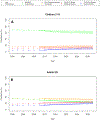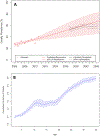Simulation of Growth Trajectories of Childhood Obesity into Adulthood
- PMID: 29171811
- PMCID: PMC9036858
- DOI: 10.1056/NEJMoa1703860
Simulation of Growth Trajectories of Childhood Obesity into Adulthood
Abstract
Background: Although the current obesity epidemic has been well documented in children and adults, less is known about long-term risks of adult obesity for a given child at his or her present age and weight. We developed a simulation model to estimate the risk of adult obesity at the age of 35 years for the current population of children in the United States.
Methods: We pooled height and weight data from five nationally representative longitudinal studies totaling 176,720 observations from 41,567 children and adults. We simulated growth trajectories across the life course and adjusted for secular trends. We created 1000 virtual populations of 1 million children through the age of 19 years that were representative of the 2016 population of the United States and projected their trajectories in height and weight up to the age of 35 years. Severe obesity was defined as a body-mass index (BMI, the weight in kilograms divided by the square of the height in meters) of 35 or higher in adults and 120% or more of the 95th percentile in children.
Results: Given the current level of childhood obesity, the models predicted that a majority of today's children (57.3%; 95% uncertainly interval [UI], 55.2 to 60.0) will be obese at the age of 35 years, and roughly half of the projected prevalence will occur during childhood. Our simulations indicated that the relative risk of adult obesity increased with age and BMI, from 1.17 (95% UI, 1.09 to 1.29) for overweight 2-year-olds to 3.10 (95% UI, 2.43 to 3.65) for 19-year-olds with severe obesity. For children with severe obesity, the chance they will no longer be obese at the age of 35 years fell from 21.0% (95% UI, 7.3 to 47.3) at the age of 2 years to 6.1% (95% UI, 2.1 to 9.9) at the age of 19 years.
Conclusions: On the basis of our simulation models, childhood obesity and overweight will continue to be a major health problem in the United States. Early development of obesity predicted obesity in adulthood, especially for children who were severely obese. (Funded by the JPB Foundation and others.).
Figures




References
-
- Gordon-Larsen P, Adair LS, Nelson MC, Popkin BM. Five-year obesity incidence in the transition period between adolescence and adulthood: the National Longitudinal Study of Adolescent Health. Am J Clin Nutr 2004;80(3): 569–75. - PubMed
-
- Janssen I, Katzmarzyk PT, Srinivasan SR, et al. Utility of childhood BMI in the prediction of adulthood disease: comparison of national and international references. Obes Res 2005;13:1106–15. - PubMed
MeSH terms
Grants and funding
LinkOut - more resources
Full Text Sources
Other Literature Sources
Medical
